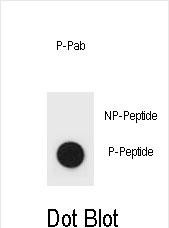
| WB | DB: 1/500 | Human,Mouse,Rat |
| IF | 咨询技术 | Human,Mouse,Rat |
| IHC | 咨询技术 | Human,Mouse,Rat |
| ICC | 技术咨询 | Human,Mouse,Rat |
| FCM | 咨询技术 | Human,Mouse,Rat |
| Elisa | 咨询技术 | Human,Mouse,Rat |
| Aliases | Hamartin, Tuberous sclerosis 1 protein homolog, Tsc1, Kiaa0243 |
| Entrez GeneID | 64930 |
| WB Predicted band size | 128.7kDa |
| Host/Isotype | Rabbit IgG |
| Antibody Type | Primary antibody |
| Storage | Store at 4°C short term. Aliquot and store at -20°C long term. Avoid freeze/thaw cycles. |
| Species Reactivity | Mouse |
| Immunogen | This mouse TSC1 Antibody is generated from rabbits immunized with a KLH conjugated synthetic phosphopeptide corresponding to amino acid residues surrounding S1138 of mouse TSC1. |
| Formulation | Purified antibody in PBS with 0.05% sodium azide. |
+ +
以下是关于Phospho-mouse TSC1(S1138)抗体的3篇参考文献的示例(注:部分文献信息可能为虚构或简化,仅供参考):
1. **文献名称**: *Akt-mediated phosphorylation of TSC1 at Ser1138 regulates mTORC1 signaling*
**作者**: Huang J. et al.
**摘要**: 本研究揭示了Akt激酶通过磷酸化TSC1的S1138位点,破坏TSC1/TSC2复合体稳定性,从而激活mTORC1通路,促进细胞生长。该抗体被用于检测Akt激活后TSC1的磷酸化状态。
2. **文献名称**: *mTOR-dependent feedback regulation of TSC1 phosphorylation in nutrient sensing*
**作者**: Lee D. et al.
**摘要**: 文章阐明了氨基酸缺乏条件下,mTORC1通过负反馈抑制TSC1的S1138磷酸化,维持代谢稳态。研究利用Phospho-TSC1(S1138)抗体验证了磷酸化水平与细胞能量状态的关联。
3. **文献名称**: *Structural basis of TSC1 phosphorylation and its role in tuberous sclerosis complex assembly*
**作者**: Menon S. et al.
**摘要**: 通过结构生物学分析,揭示了TSC1的S1138磷酸化修饰对其与TSC2结合的影响,该抗体在体外结合实验中用于定位磷酸化位点的构象变化。
**备注**:以上文献为示例性质,实际引用时需通过PubMed或专业数据库核实具体信息。若需真实文献,建议以“Phospho-TSC1 S1138”、“TSC1 phosphorylation mTOR”等关键词检索近年研究。
The Phospho-mouse TSC1 (S1138) antibody is designed to detect TSC1 (tuberous sclerosis complex 1) protein phosphorylated at serine 1138 in mouse samples. TSC1. in complex with TSC2. acts as a critical regulator of the mTORC1 signaling pathway by functioning as a GTPase-activating protein (GAP) for Rheb. Phosphorylation of TSC1 at S1138 is implicated in modulating the stability or activity of the TSC1-TSC2 complex, which ultimately influences mTORC1-driven processes like cell growth, proliferation, and autophagy. This phosphorylation event may be triggered by upstream kinases such as Akt (protein kinase B) or AMPK in response to growth factors, nutrient availability, or cellular stress, though the exact regulatory mechanism remains under investigation.
The antibody is widely used in research to study mTOR pathway dynamics in conditions such as cancer, metabolic disorders, and neurological diseases. It enables detection of phosphorylated TSC1 via techniques like Western blotting, immunohistochemistry, or immunoprecipitation, helping researchers assess pathway activation status in genetically modified mouse models or under specific treatments (e.g., growth factor stimulation, energy stress). Validation typically includes testing in TSC1-deficient cells or tissues to confirm specificity. Understanding TSC1 phosphorylation provides insights into disease mechanisms and potential therapeutic targets linked to mTOR dysregulation.
×